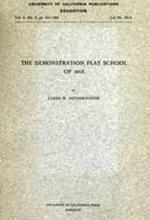
Dr. Clark W. Hetherington, a pioneer in the playground movement in America, wrote The Demonstration Play School of 1913 to report the purpose of, execution of, and success of the Summer Play School he established on the University of California Berkley campus. The experimental summer school was a combination of “the joyousness and dynamic power of play and the social purpose of education.”1
According to Dr. Hetherington, “Play, as (an) internally impelled activity, is practically the only method of education during infancy; is the most efficient method all through childhood; retains a conspicuous place during youth and even in adult life, as indicated by the modern attitude towards leisure time.”2 The Play School was organized for “uniting the spontaneous play-life of the child, who needs and desires leadership, with society's demand that he be instructed.”3
Industrialization of society shifted the centers of industry, socialization, and education away from the home and into the realm of society and schools. The schools which evolved have been designed for the convenience of the teacher in a “subject-of-study” approach. In opposition to this accepted approach, Dr. Hetherington maintained that, “In education, man has neglected, even fought nature.”4 He further declared that:
“Play is nature's method of education. Why? Because education, in its broadest sense, is identical with the process of living. More specifically, it is learning how to live through experience. But experience comes only as a result of activity, and play is the fundamental form of all developmental activity. It is spontaneous living. Out of the various reactions upon the environment that we call experience comes the development of the instincts and emotions and the experience that makes for knowledge, character and adjustment.”5
Dr. Hetherington believed that the better educational approach was to organize the child's natural play and enthusiasm through “leaders” rather than forcing on him an adult's idea of education through “teachers.” He felt that “education will be efficient when we bring the resources of adults to aid the child in his struggle for activity, experience and self-expression and when adult leaders meet the child's hunger for guidance with the spirit of a superior play-fellow and with the discipline of leadership.”6
To illustrate these beliefs, Dr. Hetherington organized the Demonstration Play School in the summer of 1913 as “the next step in the evolution of the elementary school.”7 Held at a eucalyptus grove near the university, the summer school was held in the mornings for six weeks, the afternoons being reserved for the model playground study which was separate. The Play School involved 207 children, ages four through twelve years old, who were organized into four age groups with the older two age groups having separate classes for boys and girls.
The goals of the Play School were fivefold:
- Provide an environment for a child to develop his abilities, learn about his environment, and discover about himself through immersion in play
- Supply leadership to foster natural enthusiasm in physical, emotional, and mental skills and to assist in developing the capacity to work
- Connect specific play interests with resources to develop and deepen a child's strengths
- Observe, perceive, execute, and express clearly all activities
- Establish a moral standard for molding instinctive and emotional reactions into sound habits and judgments in line with societal ideals
The Play School was a balanced blending of physical, moral, and cultural education based around the basic types of child development which included big muscle activities, manipulating and manual activities, environmental and nature activities, dramatic activities, rhythmic and musical activities, social activities, vocal and linguistic activities, and economic activities. Department leaders led each of these areas under the direction of a general supervisor. Though these leaders were largely school teachers and had a tendency to revert to their “teaching” ways, as they came to see clearer the mission of the Play School, their “enthusiasm and self-sacrificing devotion” contributed greatly to the school's success.8
Among the successes of the Play School was the children's greater health, happiness, alertness, sense of freedom, and the striking ability to concentrate among a busy play yard. At times they were able to achieve the ideal situation of eager and intense efforts by the children aided by an adult leader to guide and reinforce their passions with resources and encouragement. Parents, department leaders, observing visitors as well as the children themselves were supportive of the Play School, and the program continued under Dr. Hetherington's direction for another three years and then for another 17 years under Mrs. Hetherington's direction.
Declaring the current “mind-deadening desk and schoolroom programme of 'studies'” to be cruel, Dr. Hetherington maintained the solution was “reinterpreting the school as an open-air, educationally fused play and school center” which was organized around student activities aided by adult leaders.9 Both the Play School and the resulting report, The Demonstration Play School of 1913, embodied and quantified his vision of the importance of play in children's development and education.
- 1. Butler, George D. Pioneers in Public Recreation. Minneapolis, MN: Burgess Publishing Company. 1965. p. 21.
- 2. Hetherington, Clark Wilson. The Demonstration Play School of 1913. Berkley, CA: University of California Publications. July 30, 1914. Vol. 5, No. 2. p. 253.
- 3. Op.cit., Hetherington. p. 243.
- 4. Op.cit., Hetherington. p. 253.
- 5. Op.cit., Hetherington. p. 247.
- 6. Op.cit., Hetherington. p. 257.
- 7. Op.cit., Hetherington. p. 267.
- 8. Op.cit., Hetherington. p. 282.
- 9. Op.cit., Hetherington. pp. 265-266.

